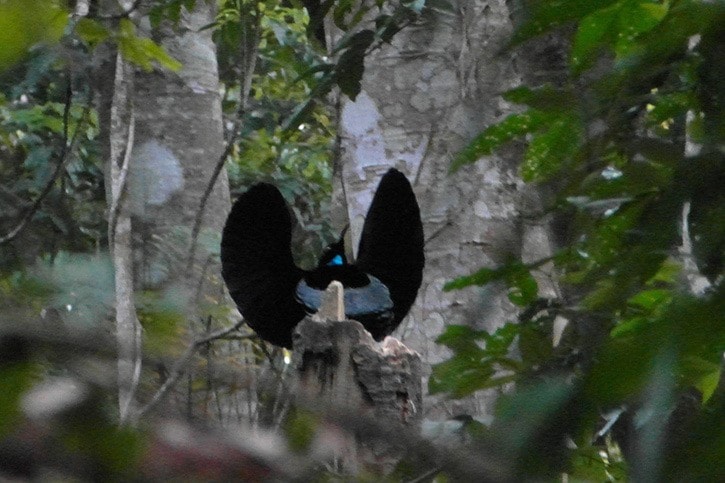Since my last article, we have moved slowly from northern Queensland to the southeast corner. Queensland is a large state; we are now over 1,500 km south of Port Douglas where we spent most of September and October.
Not surprisingly, the bird species change significantly over such a distance. There are three species pairs which seem to illustrate this quite well. In the northern rain forests there are Victoria’s Riflebird, Spotted Catbird and Chowchilla; in the southern rain forests these three are replaced by some very similar species: Paradise Riflebird, Green Catbird and Logrunner.
The riflebirds are members of the birds of paradise family. This spectacular family, known for their very elaborate courtship displays, are found primarily in Papua and New Guinea. The two riflebirds, (along with a third one that occurs only in the extreme northern tip of the Cape York Peninsula), are very similar in appearance and at first glance seem to be uniformly black. But the black plumage is highly iridescent and each time it turns slightly, colours flash from the feathers. Like other members of the family, it uses ‘body language’ as part of its courtship display. Birds of paradise seem to be able transform their bodies into amazing shapes to create dazzling images for the females to judge. This is hard for the casual photographer to capture on film, but the attached low quality image will give you some idea.
The catbirds are not in any way related to the Grey Catbird of North America. It has a similar name because like our catbird, the Australian catbirds make a lot of cat-like sounds. Again, both species are very similar in appearance with a bright green back and generally streaked and speckled underside. They are rainforest birds that primarily eat fruit, but they also have a reputation for sometimes taking young from other birds’ nests.
The Chowchilla and the Logrunner are not similar in appearance, but are very similar in habits. Both feed on food items found amongst the leaf-litter on the rainforest floor. Typically, it is their scratching in the leaves that first gives away their presence. The Chowchilla is black above and white below with a prominent bluish-white eye-ring. In contrast, the Logrunner is mix of browns, black and white providing fairly effective camouflage against a dry leafy background. Both species make a large dome nest on the ground.
In my last article I mentioned the diversity of honeyeaters in Australia. At that time we had encountered 25 different species. Since we’ve been moving south, we’ve been able to add to this list and we can now claim more than 30 members of this large and interesting group of Australian birds. The list will continue to grow as we move still further south in the next couple of months.
